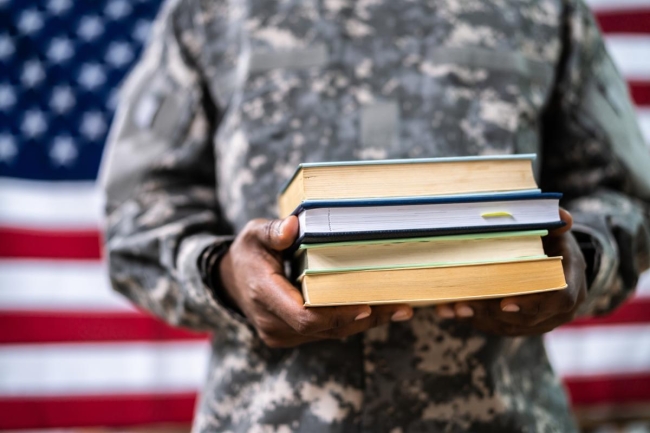You have /5 articles left.
Sign up for a free account or log in.

AndreyPopov/iStock/Getty Images Plus
More than 14 years ago, a young Marine walked into my office in the health center on our college campus and asked me, “Can you help me develop a veterans’ center on campus?”
My initial thought was “I don’t know much about veterans,” but I agreed to make this happen. My research began.
I developed two Veterans’ Resource Centers at two colleges, I have written more than $4 million dollars in grants to support our veterans and I’ve written four research reports about difficulty transitioning from the military with guidelines for how we can improve the success rates of veterans who enroll in our community colleges. In my research I have worked with a team of experts, completed pilot programs to see what works and what does not, and essentially established a template for how to help a veteran who is transitioning into civilian—and college—life.
My close friend who is a major general once told me that the military breaks down our young men and women when they enter active-duty status to build them up in the “military way of life.” A question I have asked about our veterans when they are discharged is who is there to rebuild them back to civilian life? Ince when I visited Fort Bliss, I asked this question of the colonel who served as my guide. I told him I felt the military just drops our men and women off at the street corner when they are done with them. He disagreed, but I told him, “You know how I know this? Because my colleagues and I are picking them up on the street corners.”
Fortunately, veterans are able to enter the community college system due to easy access and use their GI Bill education benefits for tuition, food and housing costs. California’s community colleges have done an exceptional job developing Veterans’ Resource Centers (VRCs) at many of the 116 colleges within the state. Approximately 90 colleges across the state currently have VRCs that function at varying levels. The VRCs operate as a one-stop location for veterans to apply for benefits, access educational plans and receive mental health support. They essentially operate as a place to heal after numerous deployments and in the aftermath of injuries, both physical and mental, obtained while serving in the military.
I put together a team to conduct research throughout the California Community College system and found data revealing the continued need for intervention and prevention around medical issues such as tinnitus and musculoskeletal injuries (including shoulder, knee and back injuries), as well as for mental health issues including depression, anxiety and panic attacks.
For our most recent report, titled “Veteran Mental Health and Transition Support” (2021), we surveyed 483 veterans enrolled in 71 colleges across the state and found that mental health issues among student veterans are substantial. Two-fifths said they’d received a formal diagnosis of anxiety or depression, and another one-fifth believed they might be suffering from anxiety or depression. More than half of student veterans have either been diagnosed or feel they suffer from post-traumatic stress disorder. One-fourth reported social isolation, and more than two-fifths reported experiencing moderate to severe anxiety. More shockingly, 33 percent indicated they had thought about ending their lives, and 11 percent reported self-harm without wanting to die.
We need to advocate for changes in the military and the Department of Veterans Affairs health-care system for better prevention and treatment of health issues ranging from tinnitus to PTSD. Meanwhile, within our colleges the research we have completed points a way toward innovative programmatic solutions to address the issues.
To address student veterans’ health-care needs, the following components should be in place:
- Provide an initial intake in the VRC upon enrollment for all veterans each semester and add free mental health screening as a standard component.
- Increase access to mental health services within the VRC. Add groups and specific targeted programs focused on issues such as addiction, PTSD and building skills and tools for acclimation from military life.
- Start prevention and intervention marketing and social media campaigns to address suicidal ideation, how to assess for signs and where to go.
- Develop peer-to-peer mentoring programs that include a buddy system for veterans upon enrollment in your college. Follow up weekly and monthly to assure needs are met and questions are answered.
- Build campus programs to address the needs of our veterans. Identify campus services and individuals by name rather than just giving veterans a number to call.
- Streamline access to support services and enrollment into VA health care and provide advocates to assist and support students in accessing VA appointments and meeting their medical and mental health needs.
In conclusion, I have found two components in our research that promote veterans’ success. The first component is to promote a holistic environment where veterans are welcome and all support entities, including resources for mental health and well-being, are in one location. The second component is to be authentic and build trust. Veterans need to trust those who are now in their lives: they need to build a unit like the one they had while in the military. And lastly, make sure those you ask to support our veterans really care, really want to be there and really want to serve those who have served.








